Larry Lawrence | March 6, 2019
Archives: What are the Trends in Motorcycling?
You hear a story of the decline of motorsports nearly every week. There’s no denying when you see on TV sparsely populated grandstands that were once packed at NASCAR events, that something fairly dramatic is going on in terms of just the general interest in motor racing. In motorcycle racing the trends are also down overall in terms of attendance and general interest. And that applies pretty much across the board in all genres of the sport with a few notable exceptions.
Archives: What are the Trends in Motorcycling?
The decline in the interest of motorsports -motorcycle racing specifically – and motorcycling in general have been discussed and contemplated a lot in recent years. In 2017 Give A Shift issued results of an industry survey that concluded, in part, that motorcycle sales continued to be flat coming off the disastrous downturn caused by the Great Recession. Baby Boomers, the generation that pushed the popularity of motorcycle racing to all-time heights in the 1990s and early 2000s, are aging out of the sport at a rapid rate. Additionally, the report was somewhat critical of the motorcycling industry for catering to the ever-decreasing demographic of established riders instead of working to attract a younger generation of riders.
Google has been around long enough now, that there is beginning to be decent historic data showing trends based on searches that reveal interesting insights into where the various segments of motorcycling were 15 years ago and tracking them to where they are today.
In this week’s Archives we’ll take a look at what Google can tell us about certain segments of the sport. While not a perfect indicator of the health of any particular segment of racing, Google Trends provides insights into what people are searching for on the Web and with the mass of data compiled by the most visited website in the world, we can at least understand the broad interest trendlines of various sectors of motorcycle racing.
Motorcycle Racing
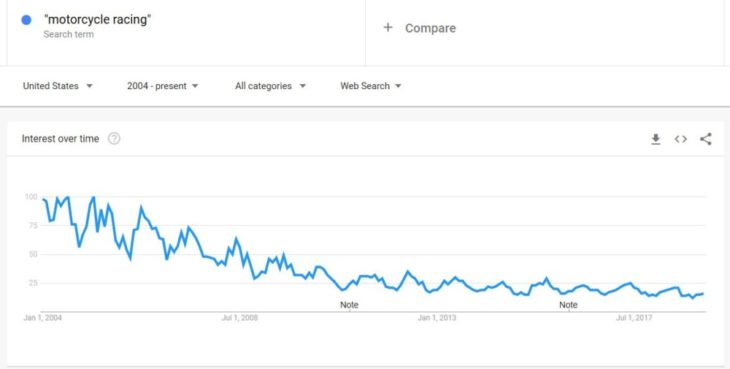
I used the search of the generic phrase “motorcycle racing” to serve as a baseline in the overall interest of the sport in general, regardless of genre. You can easily see from this graph that interest in the last 15 years has fallen quite dramatically. In fact, overall interest in motorcycle racing in less than 20 percent of what it was in its 15-year search peak in 2004.
MotoGP and Superbike
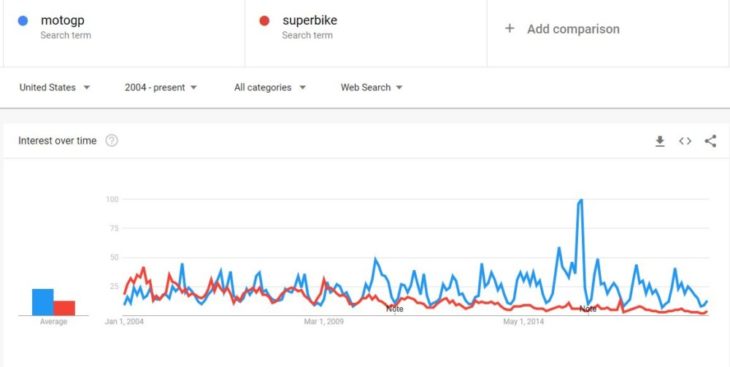
This graph shows U.S. search volume comparing MotoGP (blue line) to the generic phrase Superbike (red line). This shows us the interest in MotoGP has been rising for the last 15 years, while the interest in Superbike has been in a gradual decline.
Note how the search phrase Superbike – which could encompass a number of things from World Superbike, to domestic Superbike championships or even people simply looking for information on big-bore sportbikes – was more popular in 2004 than MotoGP.
The search phrases ran fairly evenly throughout the 2000s, with MotoGP taking a slight edge, but by the start of the 2010s interest in MotoGP in this country rises rapidly, while Superbike dwindles.
This shows us that MotoGP is one series bucking the trend of a decreasing interest in motorcycle racing. Perhaps it’s a consolidation of road racing fans as interest in America’s domestic road racing championships waned, the worldwide popularity of Valentino Rossi, the addition of two American rounds of the championship from 2008 to 2015.
Note the massive bump in MotoGP search volume at the end of 2015. That was during the height of the Marc Marquez/Valentino Rossi feud, combined with the thrilling championship battle between then Yamaha teammates Rossi and Jorge Lorenzo.
Motocross and Supercross
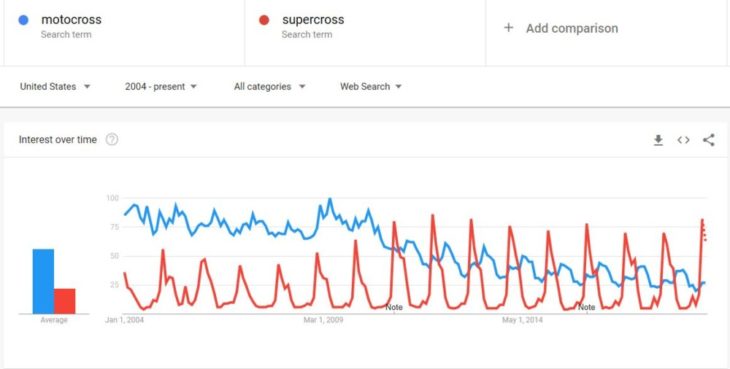
This graph clearly shows the seasonal spikes of the Supercross search phrase. Year after year, every January, Supercross search activity rockets and slowly fades during the racing season and lies practically dormant during summers months. One surprising aspect of Motocross is the fact that the search phrase actually surged during the start of the recession and has fallen since. It also shows a seasonal uptick during summer months. While the search phrase Supercross appears on this graph to be more popular, you see by the average, represented by the bars on the left side of the graph, shows motocross has considerably higher overall search activity.
Harley-Davidson and Indian
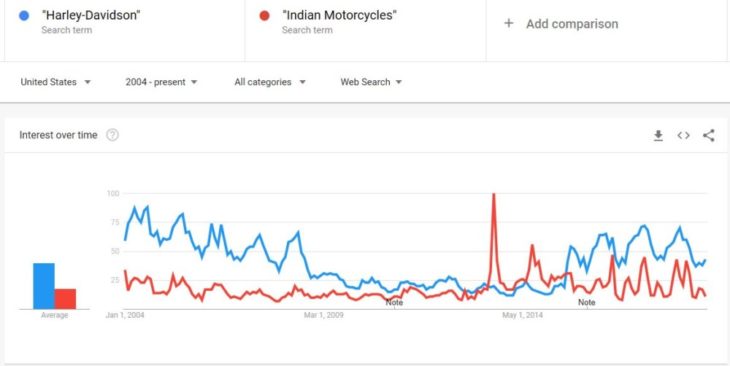
Harley-Davidson is still king when it comes to head to head searches versus Indian Motorcycles, but it’s much closer since Polaris Industries took over Indian in 2013. The massive spike in Indian search came in August of 2013, when the company announced three all-new Indian models. You can see the effects of the recession on Harley-Davidson searches, but the encouraging note for Milwaukee is starting in 2015 the search for the brand has bounced back to almost pre-recession levels.
Goodbye AMA Superbike, Hello MotoAmerica
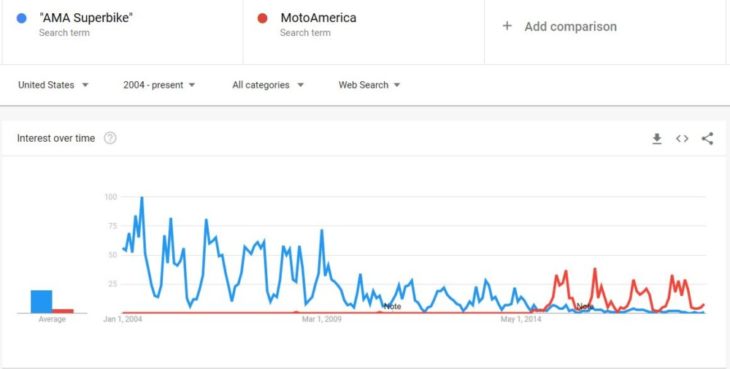
Since becoming the premier roadracing championship in the U.S. in the mid-1980s, the series was known as AMA Superbike. You can see the search for AMA Superbike dropping dramatically in the 2010s, part of that was because the DMG, which took over control of the series in 2009, added “pro” to the name, so it became AMA Pro Superbike. But probably a more important factor was the decline of interest in the series in general. Then MotoAmerica took over professional road racing in 2015. At that point the search of AMA Superbike morphs into MotoAmerica. You can also see from the graph the challenges MotoAmerica faces in getting the sport back to interest levels of the early 2000s, showing at present interest in the search term MotoAmerica is only about 40 percent of AMA Superbike in 2004.
Motorcycle Helmets
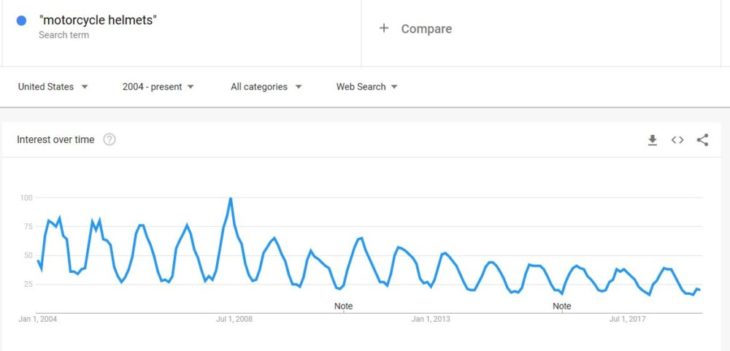
In investing circles there is something called the Men’s Underwear Index, an unconventional economic indicator, which implies a measure of how well the economy is doing can be based on the sales of men’s underwear. I thought a good comparison for motorcycling activity in general, would be something in the same line of thinking – the search phrase “motorcycle helmets”. Like men’s underwear, I theorized that the more people are looking for helmets, the better the health of the industry. As with many other motorcycling categories, you can see a strong seasonal bump in searching for helmets. Discounting the unusually high search spike in June of 2008 (possibly due to a release of a helmet safety study or some other anomaly) the graph shows search for helmets is on a slow decline, at about half of what it was during its peak in the mid-2000s. That lines up well with the U.S. sales of motorcycles, which are about half of what they were in that same time period.
These Google search trends show us what we already knew, that motorcycling, and racing specifically, is down significantly from peaks of 15 years ago. However, there are certain segments, such as MotoGP and Supercross that have been able to buck the trend. Many of these changes seem demographically driven, yet there are signs on these trend graphs that indicate the industry could be in a time of stability, where the popularity of motorcycles and racing, while not what it once was, will probably continue at near current levels of interest for the foreseeable future and not experience the dramatic swings we witnessed with the Great Recession.
Data source: Google Trends (https://www.google.com/trends).